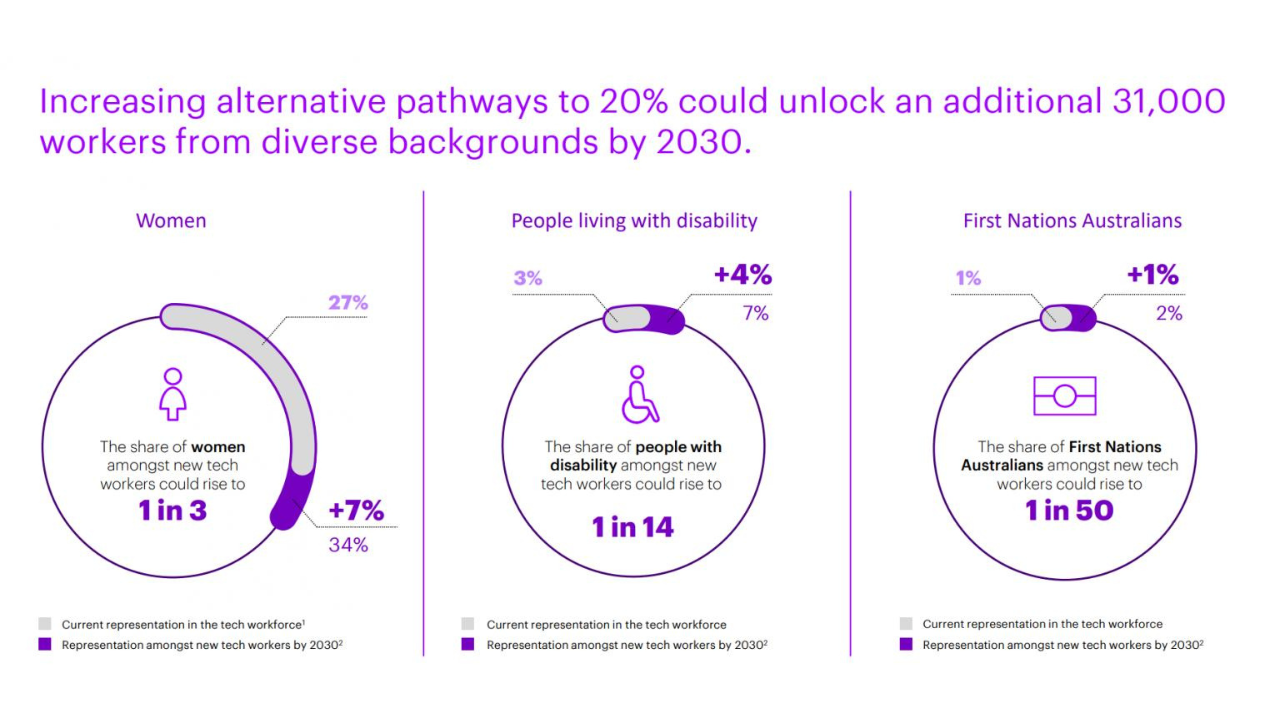
Unlocking new career pathways for 1.1 million to bridge Australia’s tech talent gap
TechnologyTalent Management#HRTech#HRCommunity
“90% of job advertisements for STEM roles across Australian organisations require a bachelor's degree or higher qualification only, ‘filtering out’ potentially high-performing candidates,” according to a report by Accenture jointly with Microsoft.
The report, 'Break down the Barriers' highlighted that such an approach neglects under-represented groups including, women, people with disabilities, and indigenous people. Moreover, only a third of university graduates with STEM degrees are women. Meanwhile, only 5% of students with a disability and 1% of students identifying themselves as First Nation person, opt for a STEM (Science, Technology, Engineering, and Mathematics) degree.

Significantly, organizations that hire or invest in alternative pathways within Australia's tech sector for these groups, comprising more than 1.1 million individuals, could open the door to a more diverse and inclusive workforce. Ultimately, resolving the future shortages of tech skills in the country.
Furthermore, the Tech Council of Australia predicts the requirement for an additional 186,000 workers in order to fulfil the government's objective of occupying 1.2 million tech-related job roles by 2030. The government will also focus on initiatives like skilled migration and upskilling workers through on-the-job training in addition to the skill and pathway programmes designed as per the demands of the tech sector.
Tenielle Colussi, Managing Director of Accenture Australia stated, “We have a real opportunity to make a difference. Gone are the days when candidates needed a degree to be considered for a role. By removing barriers and ensuring job opportunities are open to those who have alternate pathway experience, or offering programs that include alternative pathways, we’re not only solving a talent gap but creating exciting and fulfilling opportunities for amazing individuals who would have remained hidden in the workforce.”
The report notes that the benefits of alternative pathways – including speed to competency, tailored support, practical learning, flexible experience, industry connections, and lower costs to learn – are especially relevant for under-represented groups.
Setting up a new objective
According to the report, a strategic change is needed for attracting and retaining talent in Australia’s tech sector, with a focus on skills rather than degrees. Organisations should target hiring about 20% of early-career tech workers via alternative pathways by 2030. These pathways (other than a bachelor’s degree) are
- Course-based learning including vocational education and training courses, micro-credentials and vendor courses
- Intensive pre-work courses including boot camps
- Work-integrated learning including apprenticeships, cadetships and traineeships
This approach might result in an extra 31,000 workers from various backgrounds, such as women, individuals with disabilities, and First Nations people. Apart from having a significant impact on the business performance and the economic outlook of Australia, the benefits will include:
- An extra $550 million in earnings for newly employed tech workers
- 2,000 workers (formerly unemployed) transitioning to tech positions
- Government receives $250 million in extra tax revenue as workers move to more productive sectors of the economy
- A fivefold increase in talent applying for each open position in tech, significantly expanding the pool of talent
- $35 million in social services savings for the government due to a decrease in the unemployment rate
Commenting on the report analysis, Steven Worrel Managing, Director of Microsoft Australia said, “This report highlights the incredible opportunity that remains untapped in our diverse workforce, and how Australia and our economy can benefit from making the tech industry more accessible and inclusive. This isn’t just about corporate responsibility – it’s a strategy proven to yield significant economic and social returns.”
Measures for talent lifecycle
Achieving the target will require joint efforts of Australia’s organisations, tech industry, government, education providers as well as, not‑for‑profit organisations. Furthermore, organisations are in different stages of implementing alternative pathways and need to provide action across the whole talent lifecycle, and by taking practical actions like planning, hiring, training and retaining phases, they can accelerate the process.
Another report titled ‘Harnessing the hidden value: How US tech workers boost the growth of Australia’s tech ecosystem’ by the Tech Council of Australia suggests that experienced workers play a crucial role in training early-career workers. Under the mentorship of experienced workers within US tech companies, over 25,000 early-career workers advance their careers each year, stated the report.
To increase the diversity of Australia’s tech talent pipeline, the report suggested the following actions -
- Introducing an awareness campaign spotlighting the achievements of accomplished individuals from under-represented groups who have followed non-traditional routes into their careers.
- Establishing a digital apprenticeship program to enhance the accessibility and appeal of tech positions for underrepresented groups.
- Developing skill standards and pathways to streamline information access and minimize confusion regarding the necessary skills.














